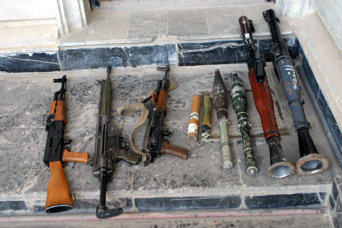- About
- Topics
- Picks
- Audio
- Story
- In-Depth
- Opinion
- News
- Donate
- Signup for our newsletterOur Editors' Best Picks.Send
Read, Debate: Engage.
When Dr. Admore Kambudzi, the acting director of the African Union Peace and Security Department stood to give his opening statement at the recently concluded 8th meeting of the AU-Regions steering committee on Small Arms and Light Weapons (SALW) and Disarmament, Demobilization and Reintegration (DDR), majority of the delegates already knew half of the content of his speech. For besides painting a propitious picture of major gains in arresting the proliferation of small arms, there has been a general feeling across the continent that the crisis has reached epidemic proportions with deaths associated with arms in the wrong hands being a common occurrence.
The much hyped disarmament exercises have proven counterproductive either because of being poorly coordinated or the blatant double speak from powers that be, who only pay lip service to these disarmaments.
Indeed the illicit arms trade is a lucrative business across Africa, with certain scholars arguing that the coup de tats and armed conflicts are fueled by the arms dealers who want to remain in business.
In fact, according to a report released by Oxfam International this year dubbed ‘The human cost of uncontrolled arms in Africa’ the proliferation of small arms has been identified as the major catalyst of prolonged conflicts, inter communal strife and even proxy wars. The report further notes that though data on fatalities caused by conflict is scarce and inconsistent, the numbers stand in millions. It for example cites the period between 1983 and 2005 in Rwanda, Congo and Sudan where between 4.3 million and 8.4 million lives were lost as a result of armed conflict.
While the continent has taken an active role in taming this menace, through for example adoption of the Central African Convention for the Control of Small Arms and Light Weapons, their Ammunition and all Parts and Components that can be used for their Manufacture, Repair and Assembly also known as Kinshasa Convention which entered into force in March this year and giving fresh and renewed impetus and a concerted effort in fighting illegal arms, this is merely scratching the surface. These arms are still readily available and even selling for a song. One report on proliferation of arms in Africa noted that a Soviet- designed AK- 47 assault rifle goes for as little as $6 or can be exchange for a sack of grain or a chicken.
Then there are the former soldiers and militants and the issue of amnesty extended to them, a model most of governments seem keen on pursuing. While such move is deemed potent in the peace buildings efforts, this strategy should be holistic in tracking the root cause of this proliferation. In the words of the UN Small arms in Africa: Counting the cost of gun violence report, "interventions to curb the demand for small arms should focus on the alleviation of poverty and structural inequality, thereby helping to reduce some of the factors prompting people to keep or acquire weapons."
